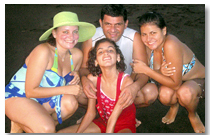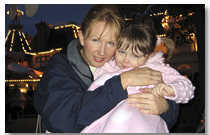Niemann-Pick
December 2010Living each day as it comes
 It was Alberto Vargas’ birthday when he got conclusive news that his youngest daughter, Valeria, had Niemann-Pick disease. Middle daughter Fernanda had already died of the incurable degenerative disorder.
It was Alberto Vargas’ birthday when he got conclusive news that his youngest daughter, Valeria, had Niemann-Pick disease. Middle daughter Fernanda had already died of the incurable degenerative disorder.
“I was heartbroken. My wife took to her bed and cried for four days. In the end I said, ‘Are you going to stay here crying or are we going to carry on together?’ She said, ‘You don’t understand’ and I said ‘Of course I do but if we both sit here crying, who’s going to look after our little girl?'”
So they carried on, as they always had. A few days after Fernanda was diagnosed with Niemann-Pick (NP), the Vargas family went ahead with a long-planned trip to Disneyland. “Fer went on all the rides and had a great time, even though she said herself she’d be leaving us soon,” Alberto recalled.
In 2007, when she could no longer walk, 11-year-old Valeria swam in the Shanghai Special Olympics and won 2 gold medals. “We’d coached her for a 15-metre assisted race (with armbands) but the Chinese said it had to be 25 metres, non-assisted. In the first race, when she got to the 15-metre mark she sank. But she got her head out of the water, smiled and swam right to the end,” her father said proudly. Fernanda, then aged 14, was delighted too. “She couldn’t talk but her smile told us how pleased she was,” Alberto recalled. “She died 10 days later, happy and hoping to see us one day in heaven.”
NP is not one but a cluster of rare, inherited metabolic disorders that cause a buildup of lipids to accumulate in the liver, spleen, lungs, brain and central nervous system. These organs deteriorate until the affected person – often a child – can no longer walk, talk or eat. There is no cure.
NP types A and B are caused by an enzyme deficiency. NPA affects newborn infants and causes such severe neurological problems that most die by the age of 3. NPB, at the other end of the spectrum, does not cause brain damage and may not appear until adulthood. Sufferers may live relatively normal lives.
Fernanda and Valeria were diagnosed with NP type C. This complex genetic disease has an unclear cause – though the gene has been identified, the disease mechanism is unclear – but the end result is the same: a fatal build-up of toxic fats that kills the body’s cells. Often appearing in school-age children, it is called “childhood Alzheimer’s” because it causes dementia.
Since it affects many organs and its symptoms are slow to develop, NPC may be misdiagnosed for months, even years. When Isabel Hontanilla’s son Samuel was 3, she noticed his spleen was swollen and started asking questions. By 8 he was becoming clumsy, talking in monosyllables and having trouble reading. “The doctors said it was a learning disability, then dyslexia, then other things… It wasn’t until he was 11 that we got to Niemann-Pick,” she says.
 For Toni Mathieson the misdiagnosis was traumatic. When her newborn baby, Lucy, started swelling up, the first consultant dismissed the symptoms as “just wind”. Then another mistook her illness as NPA and told Toni, “Take her home to die”. In fact Lucy had NPC and lived until she was 4½.
For Toni Mathieson the misdiagnosis was traumatic. When her newborn baby, Lucy, started swelling up, the first consultant dismissed the symptoms as “just wind”. Then another mistook her illness as NPA and told Toni, “Take her home to die”. In fact Lucy had NPC and lived until she was 4½.
Isabel and Toni now lead the Niemann-Pick support groups in Spain (Fundacion Niemann-Pick) and the UK (Niemann-Pick Disease Group) respectively. One of these groups’ aims is to raise awareness among doctors of a disorder most have never heard of1, so they can diagnose it sooner and put families in touch with support groups for help. “The diagnosis is devastating but not knowing what is wrong is worse,” said Isabel. “When you find out, though, your world falls apart. It helps a lot to talk to someone who’s already been through it. You know you’re not alone. Then you can start to understand the disease and accept it and realise there’s a lot you can do for these children.”
The support groups also ease the burden on affected families by helping them access financial aid and equipment like wheelchairs, by organising genetic tests for relatives who may be NP carriers, and by helping respond to the needs of other children in the family, who have had to take a back seat to this all-consuming disease.
Although there is still no cure for NP, research into this “lysosomal storage disorder” is progressing, thanks largely to fundraising efforts by support groups like those in Spain and Britain. Sadly, NPA is so swift and aggressive there is no treatment. However enzyme replacement therapy, bone marrow and liver transplants may be effective in delaying the onset of NPB. A drug for NPB received orphan designation in the EU in 2001.
In the case of NPC, there are several potential ways of slowing physical symptoms and improving the patient’s quality of life, although they may not prevent neurological problems. So-called substrate reduction therapy using the drug Miglustat is the most promising and widely used treatment so far and has been approved in the US and Europe. Research is also underway on cyclodextrin, which, like Miglustat, reduces the amount of cholesterol accumulating in the body’s cells, and N-Acetyl Cycsteine (NAC), which may help detect the presence of the disease. Yet with hope of a cure still several years off, Toni, Isabel and Alberto know to cherish each day as it comes. “We all put things off until tomorrow and don’t make the most of what we have,” said Isabel. “But with this illness you learn to live for the moment.”
Although neither can walk or talk any more, Samuel, now 20, enjoys going to college and Valeria, 15, is the cheerleader for the disabled swimmers’ club her father runs in Costa Rica. “I always used to tell Fernanda: ‘Hold your head up high,'” Alberto recalled. “‘Tomorrow will be better than today.'”
1“Understanding Niemann-Pick disease type C and its potential treatment” by Jackie Imrie and Ed Wraith.
This article was first published in the January 2011 issue of the EURORDIS newsletter
Author: Gillian Handyside
Photo credits: A.Vargas & T.Mathieson
